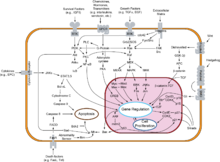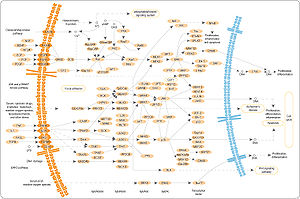- Mitogen-activated protein kinase
-
Mitogen-activated protein kinase Identifiers EC number 2.7.11.24 CAS number 142243-02-5 Databases IntEnz IntEnz view BRENDA BRENDA entry ExPASy NiceZyme view KEGG KEGG entry MetaCyc metabolic pathway PRIAM profile PDB structures RCSB PDB PDBe PDBsum Gene Ontology AmiGO / EGO Search PMC articles PubMed articles Mitogen-activated protein (MAP) kinases (EC 2.7.11.24) are serine/threonine-specific protein kinases that respond to extracellular stimuli (mitogens, osmotic stress, heat shock and proinflammatory cytokines) and regulate various cellular activities, such as gene expression, mitosis, differentiation, proliferation, and cell survival/apoptosis.[11]
 Overview of signal transduction pathways involved in apoptosis.
Overview of signal transduction pathways involved in apoptosis.
Contents
Activation
MAP kinases are activated within the protein kinase cascades called “MAPK cascade”. Each one consists of three enzymes, MAP kinase, MAP kinase kinase (MKK, MEK, or MAP2K) and MAP kinase kinase kinase (MKKK, MEKK or MAP3K) that are activated in series. A MAP3K that is activated by extracellular stimuli phosphorylates a MAP2K on its serine and threonine residues, and this MAP2K activates a MAP kinase through phosphorylation on its threonine and tyrosine residues (Tyr-185 and Thr-183 of ERK2). In vivo and in vitro, phosphorylation of tyrosine precedes phosphorylation of threonine, although phosphorylation of either residue can occur in the absence of the other. Because both tyrosine and threonine phosphorylations are required to activate the MAP kinases, phosphatases that remove phosphate from either site will inactivate them.
The MAP kinase signaling cascades convey information to effectors, coordinate incoming information from other signaling pathways, amplify signals, and allow for a variety of response patterns. They respond to different stimuli by phosphorylating cytoplasmic components and nuclear transcription factors depending on the cellular context. Down-regulation of MAP kinase pathways may occur through dephosphorylation by serine/threonine phosphatases, tyrosine phosphatases, or dual-specificity phosphatases and through feedback inhibitory mechanisms that involve the phosphorylation of upstream kinases. Drugs that selectively down-regulate MAP kinase cascades could prove to be valuable as therapeutic agents in the control of malignant disease.
Groups
ERK1 and ERK2 were the first of the ERK/MAP kinase subfamily to be cloned. Other related mammalian enzymes have been detected including: two ERK3 isoforms, ERK4, Jun N-terminal kinases/stress-activated protein kinases (JNK/SAPKs), p38/HOG, and p57 MAP kinases (38). The presence of at least six MAP kinases in yeast suggests that there are more in mammals.
- extracellular signal-regulated kinases (ERK1, ERK2). The ERK1/2 (also known as classical MAP kinases) signaling pathway is preferentially activated in response to growth factors and phorbol ester (a tumor promoter), and regulates cell proliferation and cell differentiation.
- c-Jun N-terminal kinases (JNKs), (MAPK8, MAPK9, MAPK10) also known as stress-activated protein kinases (SAPKs).
- p38 isoforms.(p38-α (MAPK14), -β (MAPK11), -γ (MAPK12 or ERK6) and -δ (MAPK13 or SAPK4)) Both JNK and p38 signaling pathways are responsive to stress stimuli, such as cytokines, ultraviolet irradiation, heat shock, and osmotic shock, and are involved in cell differentiation and apoptosis.
- ERK5. ERK5 (MAPK7), which has been found recently, is activated both by growth factors and by stress stimuli, and it participates in cell proliferation.
- ERK3/4. ERK3 (MAPK6) and ERK4 (MAPK4) are structurally-related atypical MAPKs possessing SEG motifs in the activation loop and displaying major differences only in the C-terminal extension. ERK3 and ERK4 are primarily cytoplasmic proteins that bind, translocate, and activate MK5 (PRAK, MAPKAP5). ERK3 is unstable, unlike ERK4, which is relatively stable.[12]
- ERK7/8. (MAPK15) This is the newest member of MAPKs and behaves like atypical MAPKs. It possesses a long C terminus similar to ERK3/4.
Control of the MAP kinase cascade
Receptor tyrosine kinase
Various ligands that activate MAPK’s cascade bind receptor tyrosine kinases, and tyrosine residues are phosphorylated; the phosphotyrosine residues of autophosphorylated receptors then bind the SH2 domains of adapters, (Grb2: growth factor receptor-bound protein 2). Exchange factors promote the association of Ras with GTP. GTP-Ras bind Raf-1 and B-Raf, two protein kinases. Consequently, Raf protein kinase activity is increased. Receptor tyrosine kinases have also been reported to activate the cascade in fibroblasts via a [Ca2+] increase.
G Protein-coupled receptors
The MAP kinase cascade can also be activated by certain heterotrimeric G proteins.
Protein kinase C
Protein kinase C (PKC) is used by many receptors to regulate the MAP kinase pathway, alone or in concert with other mechanisms, and may act at several steps in the cascade. PKC may directly activate Raf-1, but if a mutation exists at the site phosphorylated by PKC, no interaction can occur with Raf. Other sites of action of PKC are likely to be either farther upstream or at the level of MAP kinase inactivation.
Regulation and specificity of MEKs
MEK1 and MEK2 phosphorylate and activate MAP kinase. MEKs are activated by Raf-1, B-Raf, the Mos protooncogene product, MEK kinase 1 (MEKK1), and other growth factor-stimulated activities. The mechanisms controlling MEKK1 are unknown, although Ras may be required. It is thought MEKs are kinases that phosphorylate only MAP Kinases because no other substrates have been identified.
3D Structure of MAPK1
The MAPK1 structure consists of a smaller N-terminal domain and a larger C-terminal domain connected by a linker.
If MAPK1 is unphosphorylated its activity is very low. Phosphorylation causes both global and local conformational changes.[13] The two domains of ERK2 are rotated 17° to cause closure of the active site and form the catalytic residues. When Tyr-185 is phosphorylated binds Arg in positions -189 and −192. These new unions may help to stabilize the conformation in the active structure.
MAP kinase mutants and structural implications
Different biochemical and structural studies using mutations of the phosphorylation sites show how phosphorylation increases ERK2 activitiy. An example is that if the mutation is located in Tyr-185, it causes conformational changes that affect ERK2 activation and, so, the activity is lower. It is suggested that cells cannot tolerate the continuous activity of MAP kinase. Constitutively active mutants of MEK transform cells and generate tumors in nude mice. However, effects of activated MEKs could be compensated increasing phosphatase activity to inactivate MAP kinases.
See also
- MAPK/ERK pathway
- MAPK1 (ERK2)
- MAPK3 (ERK1)
- P38 MAPK
- MAPK14 (p38-alpha)
- Anthra(1,9-cd)pyrazol-6(2H)-one - inhibitor eg of JNK
- Arc/Arg3.1 (acts via a MAPK cascade)
References
- ^ Rossomando AJ, Payne DM, Weber MJ, Sturgill TW (1989). "Evidence that pp42, a major tyrosine kinase target protein, is a mitogen-activated serine/threonine protein kinase". Proc Natl Acad Sci USA 86 (18): 6940–3. doi:10.1073/pnas.86.18.6940. PMC 297966. PMID 2550926. http://www.pubmedcentral.nih.gov/articlerender.fcgi?tool=pmcentrez&artid=297966.
- ^ Bonni A, Brunet A, West AE, Datta SR, Takasu MA, Greenberg ME (1999). "Cell survival promoted by the Ras-MAPK signaling pathway by transcription-dependent and -independent mechanisms". Science 286 (5443): 1358–62. doi:10.1126/science.286.5443.1358. PMID 10558990.
- ^ Chadee DN, Yuasa T, Kyriakis JM (2002). "Direct Activation of Mitogen-Activated Protein Kinase Kinase Kinase MEKK1 by the Ste20p Homologue GCK and the Adapter Protein TRAF2". Mol. Cell. Biol. 22 (3): 737–49. doi:10.1128/MCB.22.3.737-749.2002. PMC 133545. PMID 11784851. http://www.pubmedcentral.nih.gov/articlerender.fcgi?tool=pmcentrez&artid=133545.
- ^ Chang L, Karin M (2001). "Mammalian MAP kinase signaling cascades". Nature 410 (6824): 37–40. doi:10.1038/35065000. PMID 11242034.
- ^ Chen YR, Tan TH (2000). "The c-Jun N-terminal kinase pathway and apoptotic signaling (review)". Int. J. Oncol. 16 (4): 651–62. PMID 10717232.
- ^ Hazzalin CA, Mahadevan LC (2002). "MAPK-regulated transcription: a continuously variable gene switch?". Nat. Rev. Mol. Cell Biol. 3 (1): 30–40. doi:10.1038/nrm715. PMID 11823796.
- ^ Kato Y, Kravchenko VV, Tapping RI, Han J, Ulevitch RJ, Lee JD (1997). "BMK1/ERK5 regulates serum-induced early gene expression through transcription factor MEF2C". EMBO J. 16 (23): 7054–66. doi:10.1093/emboj/16.23.7054. PMC 1170308. PMID 9384584. http://www.pubmedcentral.nih.gov/articlerender.fcgi?tool=pmcentrez&artid=1170308.
- ^ Kiefer F, Tibbles LA, Anafi M, Janssen A, Zanke BW, Lassam N, Pawson T, Woodgett JR, Iscove NN (1996). "HPK1, a hematopoietic protein kinase activating the SAPK/JNK pathway". EMBO J. 15 (24): 7013–25. PMC 452527. PMID 9003777. http://www.pubmedcentral.nih.gov/articlerender.fcgi?tool=pmcentrez&artid=452527.
- ^ Pearson G, English JM, White MA, Cobb MH (2001). "ERK5 and ERK2 cooperate to regulate NF-kappaB and cell transformation". J. Biol. Chem. 276 (11): 7927–31. doi:10.1074/jbc.M009764200. PMID 11118448.
- ^ Weston CR, Lambright DG, Davis RJ (2002). "Signal transduction. MAP kinase signaling specificity". Science 296 (5577): 2345–7. doi:10.1126/science.1073344. PMID 12089430.
- ^ Pearson G, Robinson F, Beers Gibson T, Xu BE, Karandikar M, Berman K, Cobb MH (2001). "Mitogen-activated protein (MAP) kinase pathways: regulation and physiological functions". Endocr. Rev. 22 (2): 153–83. doi:10.1210/er.22.2.153. PMID 11294822.
- ^ Kant S, Schumacher S, Singh MK, Kispert A, Kotlyarov A, Gaestel M. (2006). "Characterization of the atypical MAPK ERK4 and its activation of the MAPK-activated protein kinase MK5". J Biol Chem. 281 (46): 35511–9. doi:10.1074/jbc.M606693200. PMID 16973613.
- ^ Canagarajah, Bertram; Khokhlatchev A, Cobb MH, Goldsmith EJ (5). "Activation mechanism of the MAP kinase ERK2 by dual phosphorylation". Cell 90 (5): 859–69. doi:10.1016/S0092-8674(00)80351-7. PMID 9298898.
External links
- MAP Kinase Resource .
- Table of names for mitogen-activated kinases.
- MAPK cascade picture
- MeSH Mitogen-Activated+Protein+Kinases
- Model of MAPK ultrasensitivity in BioModels Database
- Drosophila rolled - The Interactive Fly
Growth factors Fibroblast EGF-like domain TGFβ pathway Insulin-like Platelet-derived Vascular endothelial Other MAP kinase activation Initiation MAP kinase kinase kinase (MAP3K or MKKK) MAP kinase kinase (MAP2K or MKK) MAP kinase Extracellular signal-regulated (MAPK1, MAPK3, MAPK4, MAPK6, MAPK7, MAPK12, MAPK15), C-Jun N-terminal (MAPK8, MAPK9, MAPK10), P38 mitogen-activated protein (MAPK11, MAPK13, MAPK14)Phosphatase Categories:- Cell signaling
- Signal transduction
- Protein kinases
- EC 2.7.11
Wikimedia Foundation. 2010.

